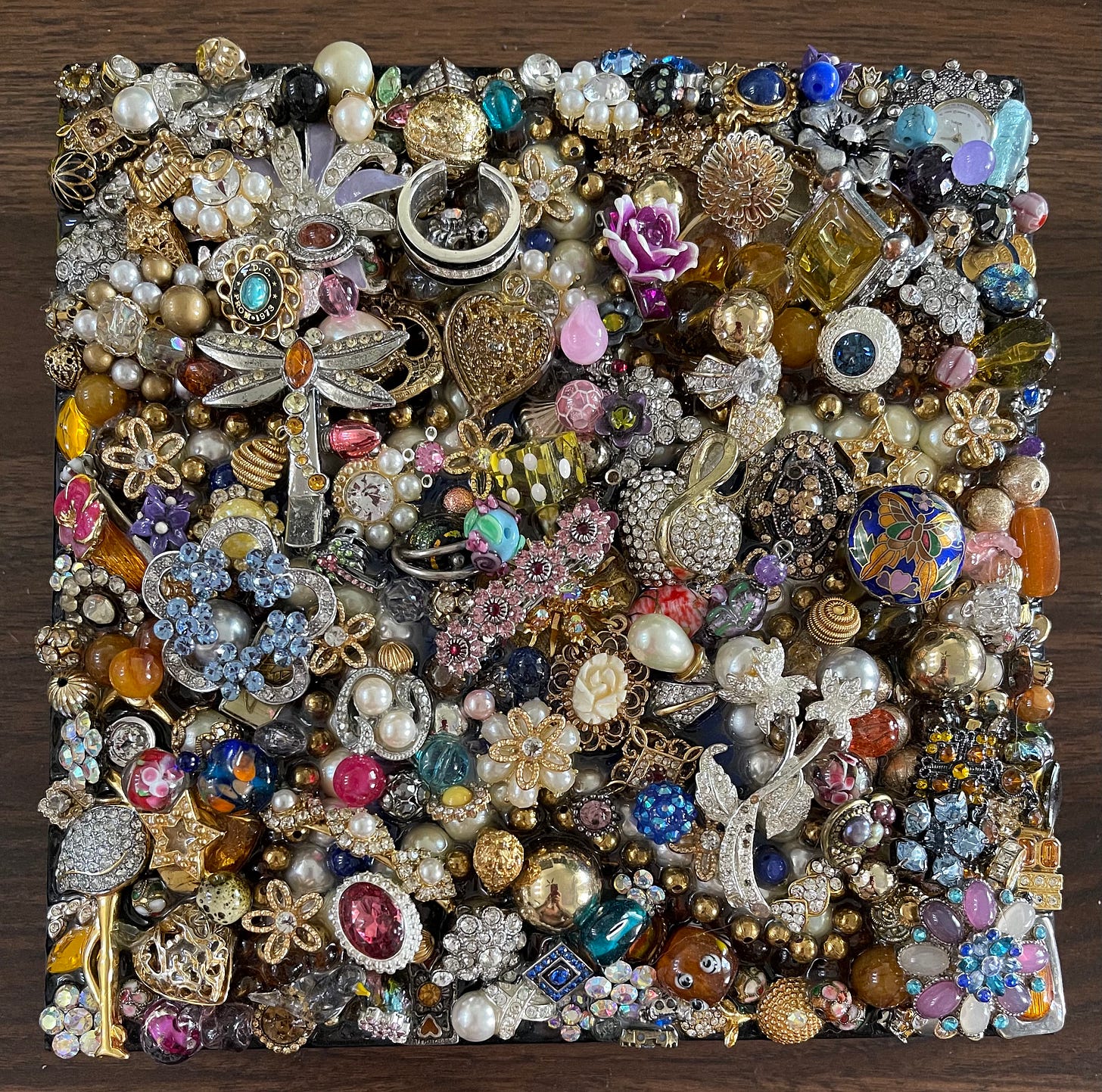I Think In Components
From XML to EDM: The Art of Rebuilding Everything From the Parts
My friends call me a digital music collage artist—which is a fancy way of saying I repurpose and rearrange bits of audio into reworked remixes of popular dance tracks. I take stems—those individual pieces of a song like vocals, bass lines, and drum loops—and weave them into something fresh. Something that moves you, maybe even makes you sweat a little (or a lot) on the dance floor.
See also: The Audio Wrangler channel on SoundCloud
That instinct to break things down and build them back up again doesn’t stop with music. It shows up in my art, too.
I make art using discarded components from old, broken, costume jewelry. Not to fix them. Not to make new jewelry. But to make something else entirely—art born from scraps of jewelry. And, not surprisingly, it’s the same instinct that drives my work in technical documentation.
Give me a bloated, chaotic content mess, and I’ll reach for a triple cappuccino and start breaking it into reusable, structured pieces. DITA XML? Topic-based authoring? I was doing that in my head before I even knew those words existed. Turns out, I don’t just think in components—I live in them.
See also: How Topic-based Authoring Improves Technical Content
Clues From the Beginning
I should’ve known early on. While other kids were busy making LEGO castles that collapsed on impact, I was sorting bricks by size and color like a tiny obsessive archivist. My mixtapes weren’t just collections of songs—they were carefully sequenced journeys. In school, I wrote essays as modular chunks. Need a stronger intro? No problem—I’ll just swap it with Paragraph Four and add a bridge. I didn’t rewrite; I rearranged.
So when I found myself building documentation experiences using structured content systems for a living, I wasn’t surprised. I was relieved. Finally—a career that matched my wiring. Where other people saw a 100-page help guide, I saw reusable topics, structured metadata, and a tidy library of content waiting to be reused like audio loops in a remix.
Topic-Based Authoring: The Tech Writer’s Remix
In technical documentation, this modular mindset shows up as topic-based authoring. Instead of writing one long, never-ending blob of text, we create small, focused content chunks—each one with a purpose. These “topics” get assembled into deliverables, tailored for different audiences, platforms, and moments in the customer journey.
Request a copy of Customer Journeys and Content Mapping
People sometimes imagine tech writers rewriting the same paragraph a dozen times. But that’s not how it usually happens. What actually happens is this: someone writes a useful piece of content, then copies and pastes it into ten different places. It works—for a while. But when the information changes, nobody remembers where it got pasted. Cue the scavenger hunt.
What I do is build systems that eliminate that mess. Write it once. Reuse it wherever you need it. Update it in one place, and watch the updates ripple out everywhere it appears. It’s the remix logic, but for content instead of club tracks.
Components Everywhere
This modular way of thinking doesn’t clock out when I’m off the clock. It shows up in my music studio, where I isolate and manipulate stems to create new mixes. And it follows me into the art studio, where I collect busted brooches, loose gemstones, and lonely earring halves, and turn them into layered, visual compositions. Nothing matches, but everything belongs—because that’s what happens when you think in components. You see how the parts fit together, even when no one else can.
A Career That Fits the Wiring
Let’s face it: no kid grows up dreaming of becoming a DITA XML expert. It’s not the kind of goal you scribble in your fifth-grade journal next to “astronaut” and “pop star.” But for someone whose brain naturally dissects and reassembles everything, it’s a perfect match.
This career didn’t just find me—I made it make sense. My modular thinking gave me an advantage, and education and experience helped me sharpen it. Now I help companies untangle their content chaos and build smart, scalable systems. And yeah, it’s deeply satisfying—like dropping the perfect beat on a crowded dance floor or turning a forgotten box of junk costume jewelry into something that belongs in an art gallery.
If You Think in Pieces, That’s a Gift
If you’re the kind of person who instinctively pulls things apart to see how they work—and then imagines better ways to put them back together—you’re in good company. That’s not a quirk. That’s a superpower.
Use it. Whether you’re remixing songs, building help site content, or gluing rhinestones to canvas, you’re doing modular thinking. And modular thinking scales. It adapts. It reuses. It takes what’s old or scattered or forgotten and gives it structure, meaning, and sometimes a little sparkle. ✨






